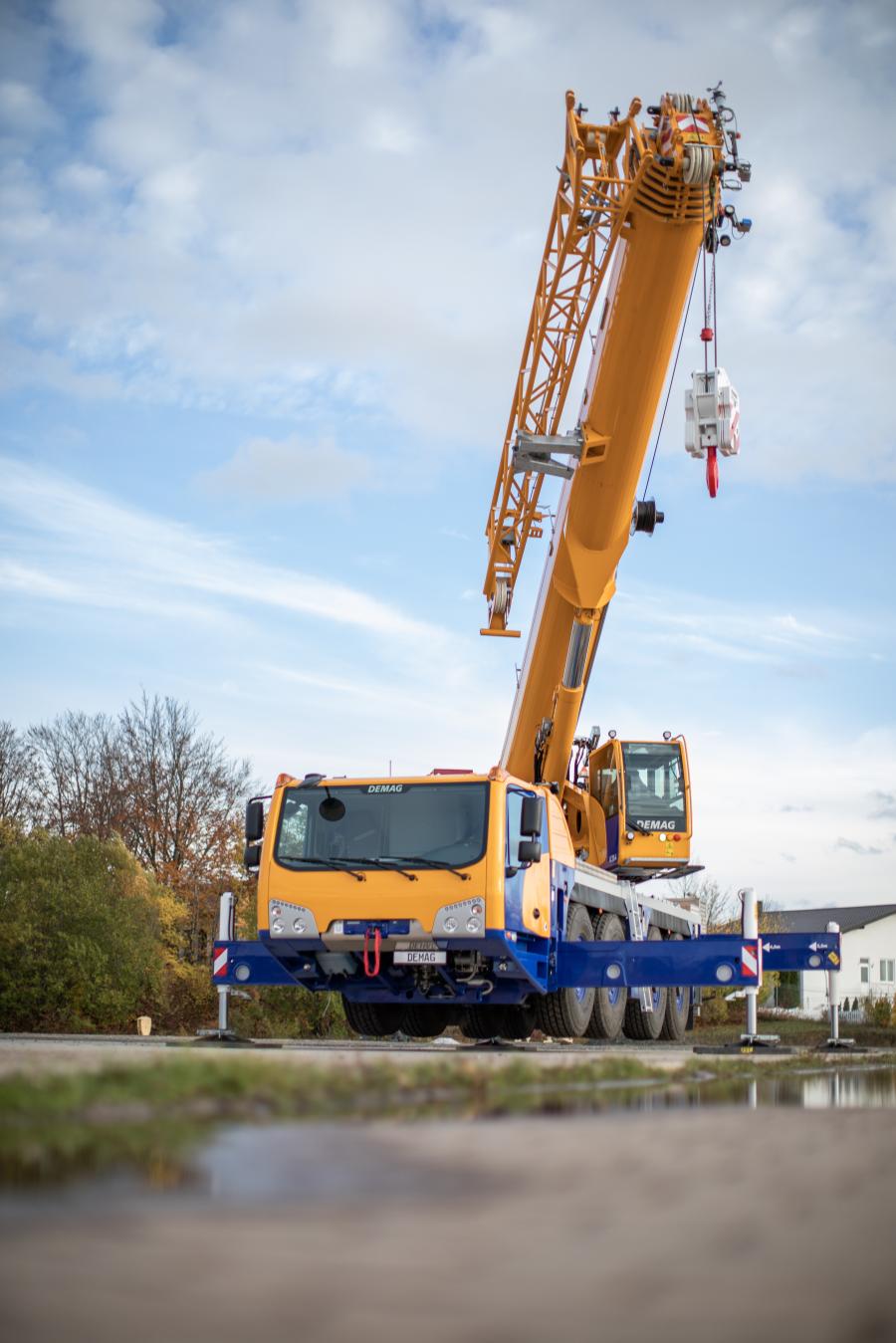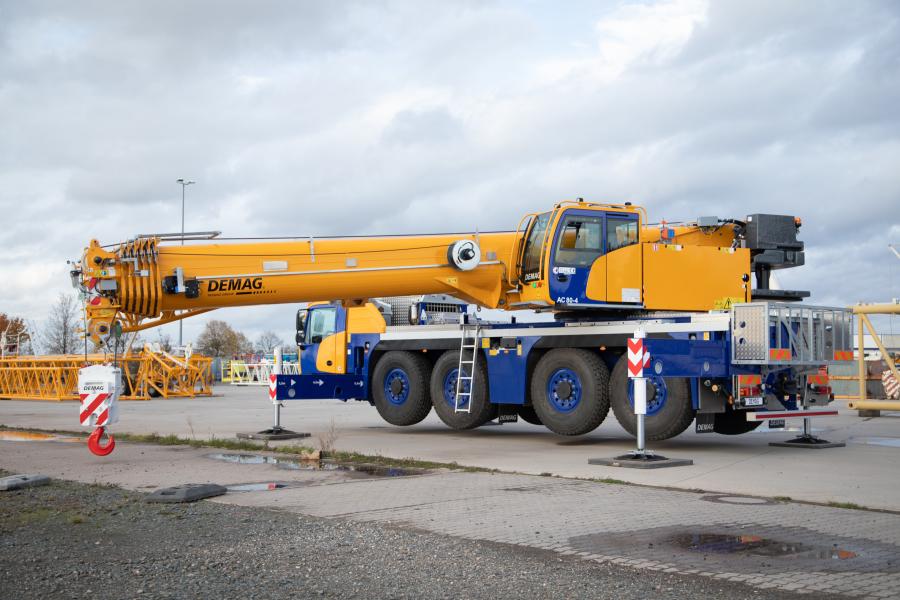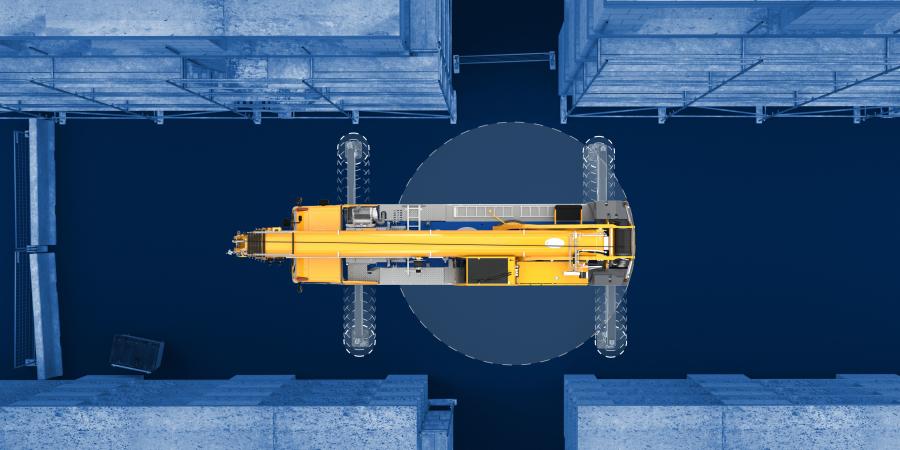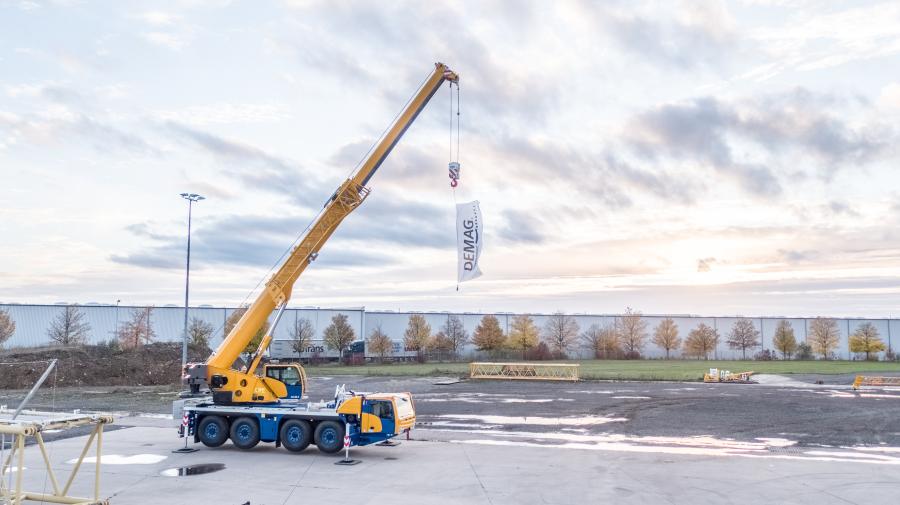The Demag AC 80-4 features a main boom that is 196.9 ft. (60 m) long and that, with some configurations, makes it possible to have the longest main boom reach in the class of up to 132 tons (120 t).
Demag already had an 88 ton (80-t) crane at one point: The AC 80-2.
"The worldwide success that this model had showed that there's significant interest in a crane with this kind of lifting capacity," said Michael Klein, the product marketing manager in charge.
"In fact, a large number of customers kept confirming this time and time again. That's why we decided to add the AC 80-4 to our product portfolio in the segment of up to 100 tonnes."
The new Demag crane really aims high when it comes to power and performance, and in many areas even outdoes representatives from the 100 ton (90-t) class, Klein said.
The Demag AC 80-4 features a main boom that is 196.9 ft. (60 m) long and that, with some configurations, makes it possible to have the longest main boom reach in the class of up to 132 tons (120 t).
And there is more: In the class of up to 110 ton, no other crane comes close to its lifting capacity with a fully extended boom up to a radius of 98.4 ft. (30 m): The AC 80-4 can lift 6 tons (5.4 t) at a radius of 45.9 ft. (14 m). It also raises the bar with its main boom extended to 164.0 ft. (50 m): At a radius of 32.8 ft. (10 m), it can lift 10.7 tons (9.7 t), which is 2.4 tons (2.2 t) more than the next most powerful competitor, according to the manufacturer.
In terms of line pull, the Demag AC 80-4 also is ahead of the pack with 66.9 kN, or 7.5 tons (6.8 t).
If the main boom length of 196.9 ft. (60 m) is not enough, the reach can be expanded with a 21.3 ft. (6.5-m) main boom extension that can be offset by 25 and 50 degrees.
Its capacity is 26.2 tons (23.8 t), meaning that it can be used to lift heavy loads over obstacles. Since the extension can be folded and carried on the main boom, it can be ready for use particularly quickly. In addition, there is a 4.9 ft. (1.50-m) runner with a capacity of 29.3 tons (26.6 t) available for the Demag AC 80-4.
The AC 80-4 also is recommended for indoor projects. The main boom can be lowered up to 3 degrees below its horizontal position so that potential work at height can be easily eliminated and the jibs can be installed quickly and safely.
The Most Compact Crane in its Class
All Demag all terrain cranes are characterized by a compact design, and the new AC 80-4 is no exception: Nearly all of its dimensions are shorter than those of other four-axle units in its class. Its total length is 39.9 ft. (12.15 m), the carrier length is 34.8 ft. (10.60 m), its height does not exceed 12.6 ft. (3.85 m), and the front overhang is a modest 4.9 ft. (1.49 m).
"Together with its width of only [8.4 ft.], our AC 80-4 is better suited for tight work sites than any other crane in its class," Klein said, pointing out another crucial design advantage behind the new Demag development.

If the main boom length of 196.9 ft. (60 m) is not enough, the reach can be expanded with a 21.3 ft. (6.5-m) main boom extension that can be offset by 25 and 50 degrees.
Able to Travel on the Road with a Counterweight of 10.3 Tons
The AC 80-4 does not need to wait to get to a work site to show off its qualities. Instead, it does so already when under way. Among other things, this is due to its sophisticated counterweight design, which makes it possible to have a maximum counterweight of 19.5 tons (17.7 t). On the road, it can transport up to 10.3 tons (9.3 t) of this counterweight itself while remaining under a 13.2 ton (12-t) axle load limit, and all while also carrying the 21.3 ft. (6.5-m) swing-away jib. In fact, this configuration even includes a three-sheave hook block on board.
"With this equipment, the AC 80-4 can take care of a broad range of lifts by itself in many European countries without requiring the use of expensive escort vehicles," Klein said.
Even when staying under an axle load limit of 11 ton (10 ton), it can carry 3.6 tons (3.3 t) of counterweight. This means that it can cross bridges with a weight limit of 11 tons (10 t) without a problem and avoid time-consuming detours in many cases.
And in countries with an axle load limit of 18.2 tons (16.5 t), the AC 80-4 can even travel with its full equipment, meaning that it is pretty much self-sufficient, the manufacturer said.
Mercedes-Benz Engine and Transmission
The AC 80-4 is equipped with a powerful Mercedes-Benz engine for efficient travel and operation. It outputs a maximum power of 340 kW (462 PS) and delivers a maximum torque of 2,200 Nm. The diesel engine conforms to EU Stage V and Tier IV Final emission requirements and can be downgraded to meet ECE-R96 regulation.
A Mercedes-Benz G230-12 transmission, together with a drivetrain from the same manufacturer, is in charge of transmitting the engine's power to the road. With 12 forward speeds and two reverse speeds, all-wheel steering as standard, and two or three driven axles, this makes the AC 80-4 perfectly suited not only to the challenges of rough terrain at work sites, but also to fast travel on highways and long-distance drives, the manufacturer said.

On the road, it can transport up to 10.3 tons (9.3 t) of this counterweight itself while remaining under a 13.2 ton (12-t) axle load limit, and all while also carrying the 21.3 ft. (6.5-m) swing-away jib.
All the Highlights from the Demag World of Innovations
Once at the work site, the new Demag Surround View makes it easier for crane operators to position the AC 80-4. This system uses the four crane cameras to show a computer-assisted diagram of the possible outreach of the outriggers, as well as the counterweight tailswing radius at the crane's current location.
"Demag Surround View displays in the carrier cabin the different outrigger widths so the crane operator can position the crane on the construction site in order to extend all outriggers sufficiently far and ensure the required slewing radius. This reduces time-consuming measuring and trial and error when looking for a location, so that the crane can be ready for operation more quickly," said Klein.
Demag Surround View also supports the driver on the way to the construction site. The cameras can deliver images of the crane side areas when turning, facilitating the crane driver to detect cyclists, pedestrians or any obstacles. This function is activated automatically when the indicator is operated.
"We first showcased this feature on the AC 450-7," Klein said. "Our customers' response was so enthusiastic that we decided to also include it in the AC 80-4. And additional models will follow."
The AC 80-4 also comes with the Demag IC-1 Plus control system. During operation, IC-1 Plus calculates the crane's lifting capacity for every boom position as a function of the superstructure's slewing angle. This means that the maximum available lifting capacity can be used with any outrigger configuration, including asymmetrical ones.
This advantage is maximized when combined with the Flex Base system, which makes it possible to extend the outriggers to any point within their range, as this system enables the crane to extend its outriggers all the way to surrounding obstacles even when an asymmetrical configuration is required. That makes it possible to use the maximum possible lifting capacity in any situation and is perfect for tight work sites in particular. It also enables the already powerful AC 80-4 to take care of lifts that would normally be the exclusive purview of larger cranes – and in places that these cranes would not be able to reach at all due to their dimensions.
The expanded graphic display provides the maximum possible convenience: it is designed in the form of a capacity radar and provides crane operators with additional information on lifting capacity within the working range while accounting for the boom position and the slewing radius, Moreover, the automatic counterweight detection function supports crane operators selecting the counterweight that has been set up, as IC-1 Plus will automatically detect it.
In addition to the IC-1 Plus control system, the crane is available with the IC-1 Remote telematics solution, which makes it possible to remotely read and diagnose all important crane data and enables owners to integrate the AC 80-4 into their fleet management system.
Emissions and noise are a constantly growing problem that in many cases is no longer being tolerated, especially in larger cities. The industrial sector is expected to provide sustainable solutions that can help reduce this problem. This is why the ESTA-award-winning E-Pack is available for the AC 80-4. This feature is an electro-hydraulic system designed to be connected to the crane. It comes with an integrated 32-kW electric motor that makes extremely quiet zero-emission crane operation possible. Specific applications for the E-Pack include crane jobs inside buildings, in dense urban areas, and at night in residential areas – in other words, under conditions in which the company operating the crane may have to face stricter requirements that make conventional crane operation with a diesel engine impossible.
The Bottom Line: A Powerful and Versatile Crane
"This crane offers the versatility that our customers need," Klein said. "With its [196.9 ft.] main boom and its compact design, the AC 80-4 covers an enormous range of possible applications. This applies especially together with the IC-1 Plus control system and the Flex Base outrigger system, which will definitely make it the first crane of choice for many jobs in which space conditions are tight."
For more information, visit www.tadano.com.

The AC 80-4 also is recommended for indoor projects. The main boom can be lowered up to 3 degrees below its horizontal position so that potential work at height can be easily eliminated and the jibs can be installed quickly and safely.
This story also appears on Crane Equipment Guide.
Today's top stories


















